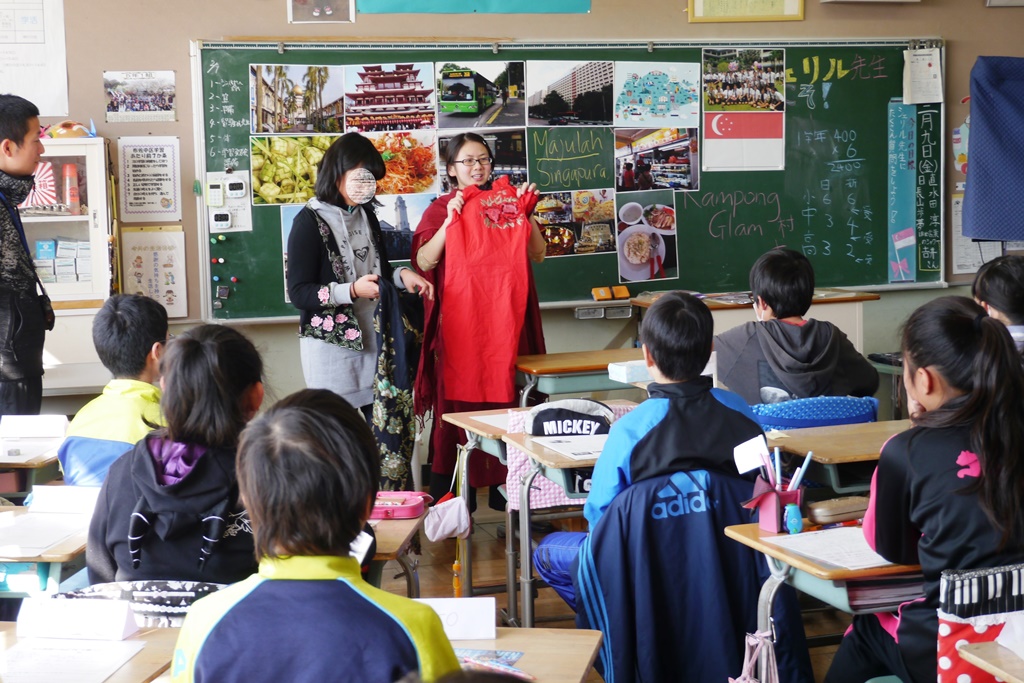
Date and time: February 9th (Friday) 11:10 ~ 12:20
Venue: At a sixth-grade classroom of Fusa Minami Elementary School
Students: 35 sixth graders
Guest teacher: Ms. Ng Cheryl (Singapore)
AIRA pick-up staff: Mr. Kudoh
Mr. Horiuchi (Association for Promotion of International Understanding)
Ms. Cheryl is studying liberal arts at the University of Tokyo. After changing into her folk costume of her ethnic group, she went to the classroom with students who came to meet her at the guest room. She also brought some folk costumes of other ethnic groups of her country
The class was designed to explore Singapore from Changi International Airport to the city, just like going on a city tour. She talked about multi-ethnicity of her country, culture, life, schools, and others. The sixth-graders did some research on the country in advance in preparation for this class. But they were so impressed and surprised to hear about many stories from her that they were taking notes intently. After her lecture, they asked many questions.
The followings are the outline of her lecture:
1. About the country:
The national territory of Singapore is an equivalent area of Tokyo Metropolitan 23 words. It takes only 90 minutes by train from the east to the west. This tiny island country is called “a little red dot”, due to a minuscule dot on a world map. Singapore has two seasons, the rainy season and the dry season, and its annual temperature is around 30 degrees Celsius. People wear a coat when the temperature goes down to 22 degrees Celsius.
Due to the narrow land of Singapore, about 80% of the population lives in apartments and takes public transportation at cheap fares. On the other hand, having a car is very expensive, at least ¥10 million.
2. About influences brought about by the multi-ethnicity
Singapore is comprised of Chinese, Malay, Indian, and other ethnic groups. There are four official languages (English, Chinese, Malay, and India-Tamil), so all station names are written in them. There are a wide variety of food, festivals, and many styles of funeral, and temples of each religion.
3. Schools and studying abroad
Singapore’s school system consists of the 6-year elementary school, the4-year junior high school, and the 2-year high school. Kids have to take an entrance examination at each stage. There are also 6-year schools which combine junior and high schools. After finishing high school, some go to local universities and about 40% of them go to other countries to study.
The followings are some of the questions the students asked.
“How long have you been studying Japanese?”
“Is there anything you were surprised by in Japan?”
“What are the good things Singapore and Japan have?”
“What are you proud of?”
“What is your favorite food?”
These questions clearly show how much the kids were inspired by her story.
At the end of the class, Ms. Cheryl talked about her future. Her parents, who were against her idea of studying abroad, wanted her to become a lawyer or a doctor. But she chose her dream of becoming an interpreter and translator who will serve as a bridge between various cultures.
She encouraged the students, saying that studying English is not so difficult for them because they have been already studying Japanese, one of the most difficult languages. She concluded her class by quoting one phrase “Majulah Singapura” or “Onward Singapore, the title of the national anthem of her country. As a supporter of this program, AIRA will be very happy if this experience exerts even a bit of influence on them in deciding their future.
(Translated by Hitomi Koyama)





